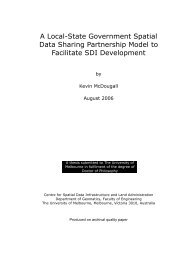Digital Lodgement of Cadastral Survey Data in Australia - Centre for ...
Digital Lodgement of Cadastral Survey Data in Australia - Centre for ...
Digital Lodgement of Cadastral Survey Data in Australia - Centre for ...
You also want an ePaper? Increase the reach of your titles
YUMPU automatically turns print PDFs into web optimized ePapers that Google loves.
Common <strong>Digital</strong> <strong>Lodgement</strong> Trends<br />
This section has highlighted trends that are becom<strong>in</strong>g <strong>in</strong>creas<strong>in</strong>gly obvious <strong>in</strong> the area <strong>of</strong> digital lodgement. One <strong>of</strong> the first<br />
po<strong>in</strong>ts to note is that many jurisdictions are implement<strong>in</strong>g digital lodgement as part <strong>of</strong> a broader cadastral re<strong>for</strong>m program.<br />
Western <strong>Australia</strong>, New Zealand and Queensland are the most obvious examples. This highlights the fact that digital lodgement<br />
cannot af<strong>for</strong>d to be treated as an <strong>in</strong>itiative on its own – it is important to consider the effects it will have on the whole <strong>in</strong>dustry,<br />
and the benefits it will provide.<br />
In the same way, a number <strong>of</strong> jurisdictions have also <strong>in</strong>troduced surveyor accreditation programs as a way <strong>of</strong> reta<strong>in</strong><strong>in</strong>g core<br />
bus<strong>in</strong>ess with<strong>in</strong> government. It also ensures that surveyors are made responsible <strong>for</strong> quality control <strong>of</strong> their own plans, to a<br />
100% error free level. It is expected that this trend will become more popular as the cadastral <strong>in</strong>dustry further enters the digital<br />
age, with more digital databases rely<strong>in</strong>g on the source data collected by the surveyors.<br />
The br<strong>in</strong>g<strong>in</strong>g together <strong>of</strong> all the land adm<strong>in</strong>istration agencies <strong>in</strong>to the one department is another trend that is bound to have<br />
positive ramifications on digital lodgement. Western <strong>Australia</strong> is a prime example <strong>of</strong> this. Previously, there were separate<br />
departments handl<strong>in</strong>g the digital cadastral database and the registration <strong>of</strong> title, however they were brought together several<br />
years ago. This is similar to the Victorian government, which has realised the benefits <strong>of</strong> manag<strong>in</strong>g all land <strong>in</strong><strong>for</strong>mation <strong>in</strong> the<br />
one department, with the br<strong>in</strong>g<strong>in</strong>g together <strong>of</strong> the Land Titles Office and the <strong>for</strong>mer Geographic <strong>Data</strong> Victoria (responsible <strong>for</strong><br />
ma<strong>in</strong>ta<strong>in</strong><strong>in</strong>g the State <strong>Digital</strong> Map Base) under the one group Land Victoria. New Zealand has also adopted this approach.<br />
Solutions to several technical issues have also been highlighted with<strong>in</strong> this paper. In terms <strong>of</strong> file <strong>for</strong>mats, Western <strong>Australia</strong><br />
has <strong>in</strong>troduced a system whereby surveyors can produce their plans <strong>in</strong> the s<strong>of</strong>tware <strong>of</strong> their choice, and then us<strong>in</strong>g translators<br />
developed <strong>for</strong> their particular s<strong>of</strong>tware, the surveyor can then lodge the plan <strong>in</strong> this <strong>for</strong>mat. This is an ideal alternative to<br />
surveyors hav<strong>in</strong>g to purchase new s<strong>of</strong>tware to accommodate digital lodgement. New South Wales are also develop<strong>in</strong>g a new<br />
file <strong>for</strong>mat to use. South <strong>Australia</strong> recommended that when digital lodgement is <strong>in</strong>troduced, firstly only the data itself should be<br />
lodged, accompanied by a hard copy plan, and secondly all <strong>in</strong><strong>for</strong>mation would be lodged digitally, which would <strong>in</strong>clude the plan<br />
graphic and the digital <strong>in</strong><strong>for</strong>mation extracted from the plan (Land Services Group, 1997).<br />
A number <strong>of</strong> jurisdictions have also adopted the concept <strong>of</strong> a coord<strong>in</strong>ated cadastre, whereby all cadastral surveys carried out<br />
must be based on the state geodetic network. New Zealand and the ACT are the furthest advanced <strong>in</strong> this area. Coord<strong>in</strong>ated<br />
surveys are expected to reduce the ef<strong>for</strong>t needed to lodge a plan, however it is important to realise that digital lodgement can<br />
still be <strong>in</strong>troduced even if the plans are not coord<strong>in</strong>ated.<br />
New South Wales has demonstrated how digital lodgement could be implemented us<strong>in</strong>g a pilot program. The program, which is<br />
now <strong>in</strong> progress, has identified issues and recruited several volunteer companies to take part <strong>in</strong> the pilot program.<br />
DIGITAL LODGEMENT QUESTIONNAIRES WITHIN VICTORIA, NEW SOUTH WALES AND<br />
SOUTH AUSTRALIA<br />
The importance <strong>of</strong> the consult<strong>in</strong>g surveyor with<strong>in</strong> the plan lodgement process is paramount, consider<strong>in</strong>g it is the surveyor who<br />
is responsible <strong>for</strong> the <strong>in</strong>itial collection and manipulation <strong>of</strong> the cadastral data. Several states have recognised the significance <strong>of</strong><br />
this role, and have requested valuable <strong>in</strong>put from the survey<strong>in</strong>g pr<strong>of</strong>ession on the issue <strong>of</strong> digital lodgement, through<br />
questionnaires. Victoria, New South Wales and South <strong>Australia</strong> have all adopted this approach <strong>in</strong> order to assess the<br />
pr<strong>of</strong>ession’s attitude towards digital lodgement.<br />
Details <strong>of</strong> Questionnaires<br />
The Victorian questionnaire was carried out by the authors <strong>of</strong> this paper. It was sent to 104 private surveyors <strong>in</strong> Victoria, all <strong>of</strong><br />
who are members <strong>of</strong> the Association <strong>of</strong> Consult<strong>in</strong>g <strong>Survey</strong>ors. It was sent <strong>in</strong> early January 1998 with a clos<strong>in</strong>g date <strong>for</strong><br />
responses <strong>in</strong> mid-February 1998. A satisfactory return rate <strong>of</strong> 42% (44 out <strong>of</strong> 104) was achieved which <strong>in</strong>dicated quite a high<br />
<strong>in</strong>terest <strong>in</strong> the general concept <strong>of</strong> digital lodgement.<br />
The questionnaire itself was four pages long, and consisted <strong>of</strong> both multiple-choice questions and short answer questions. The<br />
first two sections conta<strong>in</strong>ed questions regard<strong>in</strong>g current technology, and current survey and data lodgement practices, whilst<br />
the third section concentrated on the surveyors’ attitudes towards digital lodgement. The full results <strong>of</strong> the questionnaire are<br />
available <strong>in</strong> Falzon (1998) and are summarised <strong>in</strong> Falzon and Williamson (1998).







